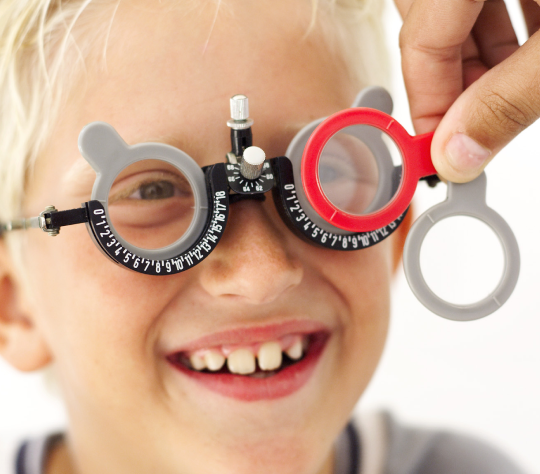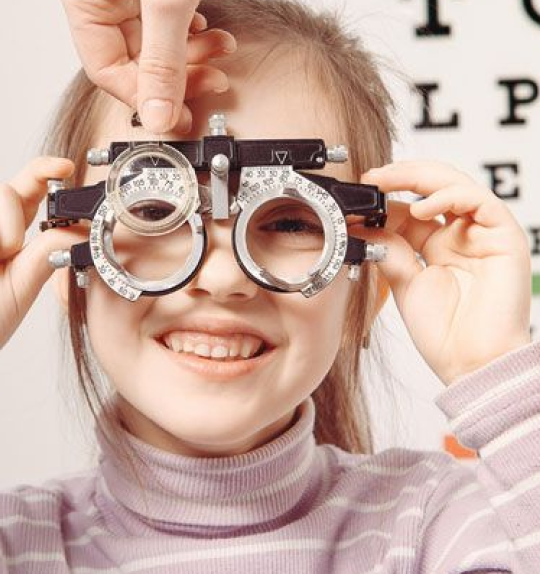Did you or your child recently get new glasses but are still experiencing headaches? Perhaps you had uncomfortable symptoms of dizziness, nausea, and headaches for months or longer and thought that new glasses would provide you with relief?
If your new glasses are making you dizzy, or if your new glasses are giving you nausea and other issues, you could be suffering from a condition known as Binocular Vision Dysfunction (BVD).

What is BVD?
When we have a misalignment between our eyes, our eyes are essentially out of sync with each other, and it is very difficult for our brain to make one clear image from the two misaligned images.
For example, most people’s brains are able to transform two separate but aligned images into a single image (known as binocular vision). But if you have BVD, the brain struggles to process the two misaligned images into one clear image. To fix the problem, the brain forces the eye aligning muscles to realign the eyes. But this realignment is only temporary, creating a continuous cycle of misalignment/realignment. As time goes on, this cycle produces an enormous amount of stress and strain on the eye muscles, which results in headaches, dizziness, nausea, and other symptoms associated with wearing new glasses that do not seem to have been made correctly.
For those experiencing a headache with new glasses, it could be due to BVD.
Can New Glasses Cause Headaches?
Yes, sometimes new glasses can cause headaches, but this should last no longer than 2 weeks. For adults and children with BVD, the headaches and other symptoms are frequent, lasting longer than two weeks, and it becomes increasingly difficult for them to find relief.
Why Do I Get a Headache from Glasses?
Adjusting to new glasses symptoms can be very uncomfortable. In addition to potentially having BVD, there are several possible reasons why new glasses are causing your headache:
Poorly Fitted Glasses
If your eyeglass frames were fitted incorrectly on your face, for example, if the frame is sitting too high or too low, or if the lenses are not properly centered on each eye, this can cause headaches from your new glasses. You should check with your eye doctor to ensure the frames/lenses were placed correctly.
New Prescription
Another possible reason you could be experiencing headaches from new glasses is the new prescription. Sometimes the new glasses cause eye strain due to this change in how your eyes see. So since your new eyeglasses contain a new prescription for your eyes (a new way of seeing the world around you), it can sometimes take a few days for your eyes to adjust.
In addition to your new glasses causing headaches, you might experience blurred vision, but these symptoms should only last for up to two weeks as your eyes adjust. Additionally, adjusting to progressive lenses can cause headaches for a temporary period of time while your eyes adapt to wearing eyeglasses. Ensure you’ve had a comprehensive eye exam and you’re wearing the correct prescription eyeglasses.
Your Glasses Have an Incorrect Prescription
If the prescription provided by your eye doctor is not an accurate prescription for your vision, it can place strain on your eye muscles that can result in the new glasses causing headaches. Additionally, new glasses causing headaches could be a result of astigmatism (an imperfection in the curvature of your eye) in which you would need a specific prescription to correct the curvature.
Digital Eye Strain
There are instances where wearing glasses is not the cause of blurry vision. Some individuals are more affected by the specific light from laptops, televisions, and phones. Sometimes, this condition is referred to as computer vision syndrome and only causes headaches when in front of digital screens for long periods of time.
Blue light glasses are sometimes used to prevent headaches when working digitally. These glasses may relieve eye strain where prescription glasses don’t.

How Long Does it Take To Get Used To New Glasses?
While getting used to new glasses lenses can take time, it should only take up to two weeks for you or your child to adjust to your new glasses. If your symptoms continue for more than two weeks, or if you had headaches and symptoms prior to your new glasses that are not improving, you might have BVD.
What are the Symptoms of BVD?
It’s common for adults suffering from headaches with new glasses to say, “These new glasses are making me dizzy,” or “When I wear glasses I get a headache.” However, the symptoms of BVD can extend beyond just headaches and can vary depending on age.
Common Symptoms for Adults with Binocular Vision Dysfunction
There are several symptoms associated with BVD in adults, which typically include the below. Some individuals experience all of these symptoms, while others experience only a few, such as headaches, nausea, and dizziness. These symptoms are also very similar to those associated with vestibular migraines and vertigo.
- Difficulty with balance / unsteady walking
- Pain in the neck
- Frequent head tilt
- Motion sickness
- Difficulty reading and learning

Headaches in Children
Nausea and headaches not only affect adults with BVD but can affect children as well. When children regularly experience headache and nausea, it can result in them missing school and therefore delaying their reading and learning, as well as possibly leading to a misdiagnosis of ADD or ADHD.
If your child has BVD, the symptoms will vary depending on their age.
For children ages 4 to 8-years-old, common behaviors and symptoms of Binocular Vision Dysfunction can include:
- Poor handwriting (poor spacing, writing letters too big or small)
- Difficulty reading
- Avoiding activities
- Playing with toys very close to their face
- Sitting close to the TV
- Difficulty identifying shapes, colors and numbers that are age-appropriate
- Difficulty seeing the class board
- Frequently bumping into objects
- Difficulty catching balls
- Stomach aches and headaches at school or away from home
- Light sensitivity
- Covering one eye to see
- Anxiety in public places
- Frequent squinting in order to see
For children ages 9 to 13-years-old, common behaviors and symptoms of Binocular Vision Dysfunction can include:
- Repeatedly bumping into things while
walking - Having difficulty completing homework due to headaches and nausea
- Repeatedly reading the same things over and over
- Sensitivity to bright lights
- Closing one eye to make it easier to see
- Blurred vision when using the computer
- Blurred vision or tired eyes when looking at the blackboard in class
- Verbal skills that are ahead of reading skills
- Frequent blinking
Treatment For New Glasses Causing Headaches
If your new glasses are causing headaches, there is treatment. At Vision Specialists of Michigan, our micro-prism lenses correct the misalignment between your eyes, allowing them to work together as a team. These specialized lenses are different than standard prescription lenses in that they specifically bend light in a way that the image seen by your eye is moved into the position it needs to be in – this results in the image becoming realigned and your headaches, dizziness, nausea, as well as other symptoms, are markedly reduced or eliminated.
Micro-prism lenses help your eyes to create one clear image, eliminating the need for your eye muscles to strain. In fact, the average patient will notice a 50 percent reduction of symptoms by the end of their first visit. Our aligning lenses are fine-tuned and perfected for you over the next several visits, helping you to continue feeling better. The result is relief from your headaches and other uncomfortable symptoms associated with BVD.
Frequently Asked Questions
New glasses can give you a headache if the frames are fitted poorly, if your eyes are simply adjusting to the new prescription, or if you were given an incorrect prescription for your vision. If your headaches last more than two weeks, or if you have not found relief from symptoms despite having new glasses, you might have BVD.
Some people do experience headaches from their new glasses, but this should only be temporary and last up to two weeks.
Yes, glasses can give you a headache due to poorly fitted frames, or from a new or incorrect prescription. It can also be a result of BVD.
Yes, many patients with BVD experience difficulty with driving. This is because two of the most common symptoms associated with the condition are headaches and dizziness, which alters your depth perception, balance, and equilibrium, essentially making it difficult to see the road, signage, and nearby cars.
BVD can be the result of your facial asymmetry (where one eye is higher than the other), nerve or eye muscle abnormality (a common condition many people are born with), or it can develop as a result of stroke, brain injury, concussion, or a similar neurological disorder.
To determine if your symptoms are the result of Binocular Vision Dysfunction, we suggest you first see your primary care physician or specialist to rule out other causes for your symptoms. If no cause is found for the symptoms, then BVD might be the issue.
- We ask you to fill out a specialized questionnaire designed to screen for those who might have BVD.
- You will be asked to complete a detailed Health History form.
- An eye exam is performed to determine the need for correction of nearsightedness, farsightedness, and astigmatism (a common imperfection in the eye’s curvature).
- A specialized exam is performed (NeuroVisual Evaluation) to determine if visual misalignment is present.
- If diagnosed with BVD, you will be fitted with a trial version of your new prescription. Most people notice a significant improvement in their symptoms within just a few minutes of putting on the trial lenses.
You can expect to spend approximately 3 hours in our office during your visit.









